The CNC slitting lathes market is valued at USD 1.7 billion in 2025 and is expected to reach USD 3.0 billion by 2035, driven by increasing demand for high-precision component machining, automated part production workflows, and multi-axis turning capabilities across medical devices, automotive components, aerospace parts, and industrial tooling segments. CNC slitting lathes support machining of small-diameter, intricate, and high-tolerance components where dimensional consistency, surface finish stability, and machining repeatability are essential. Growth is supported by the global shift toward automated manufacturing cells, reduced manual intervention requirements, and the rising need for custom-scale production flexibility in both high-volume and specialty component environments.
From 2025 to 2030, the market expands from USD 1.7 billion to approximately USD 2,240.8 million, adding USD 509.9 million and accounting for 44 percent of total decade growth. This phase is marked by rapid deployment of multi-axis CNC configurations and integrated tool-changing platforms that increase machining efficiency and reduce setup times. Manufacturers prioritize spindle stability, feed control accuracy, and software-driven machining parameter optimization. From 2030 to 2035, the market continues its advance to USD 3.0 billion, supported by broader integration of machine monitoring software, adaptive cutting algorithms, and digital twin programming environments. Suppliers offering rigid structural designs, thermal distortion compensation, and seamless compatibility with factory automation systems remain competitively positioned as CNC slitting lathes evolve into core equipment for precision part manufacturing across global industrial value chains.
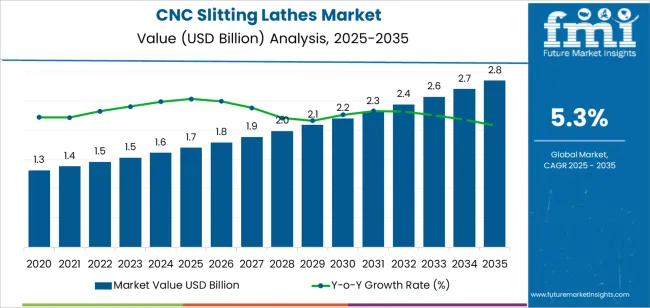
The subsequent phase covering 2030-2035 anticipates continued expansion from USD 2240.8 million to USD 3 billion, adding USD 660.2 million or 56% of the decade's total growth. This period defines broader penetration of intelligent machining technologies, integration with Industry 4.0 platforms, and seamless compatibility with existing manufacturing infrastructure. The market development indicates fundamental transformation in precision component production and quality management approaches, with participants positioned to capitalize on growing demand across multiple axis configurations and application segments. Geographic expansion patterns show concentrated growth in manufacturing-intensive regions with established precision engineering infrastructure, while emerging markets demonstrate accelerating adoption rates driven by medical device manufacturing initiatives and automotive component localization programs across production and machining facilities.
| Period | Primary Revenue Buckets | Share | Notes |
|---|---|---|---|
| Today | New machine sales | 52% | Capex-driven, capacity expansion purchases |
| Spare parts & tooling | 22% | Replacement cutting tools, components | |
| Service & maintenance contracts | 16% | Preventive maintenance, calibration support | |
| Upgrades & retrofits | 10% | Control system upgrades, automation enhancement | |
| Future (3-5 yrs) | Advanced multi-axis systems | 45-50% | Industry 4.0 integration, automation features |
| Digital monitoring services | 15-18% | Predictive maintenance, remote diagnostics | |
| Tooling & consumables | 14-17% | Precision cutting tools, specialized inserts | |
| Service-as-a-subscription | 10-13% | Uptime guarantees, performance-based contracts | |
| Training & optimization | 8-10% | Operator certification, process optimization | |
| Data analytics services | 5-7% | OEE monitoring, quality analytics, production insights |
| Metric | Value |
|---|---|
| Market Value (2025) | USD 1.7 billion |
| Market Forecast (2035) | USD 3 billion |
| Growth Rate | 5.3% CAGR |
| Leading Axis Type | Single Axis |
| Primary Application | Medical Devices |
The market demonstrates robust fundamentals with single axis systems capturing dominant share through proven reliability characteristics and medical device manufacturing optimization. Medical device applications drive primary demand, supported by increasing precision component requirements and regulatory compliance standards. Geographic expansion remains concentrated in developed markets with established precision manufacturing infrastructure, while emerging economies show accelerating adoption rates driven by medical device production initiatives and rising quality standards. The market benefits from ongoing transition toward automated precision machining requiring advanced turning solutions capable of delivering tight tolerances and consistent quality across high-value component production environments.
Primary Classification: The market segments by axis type into single axis and multi-axis CNC slitting lathes, representing the evolution from basic turning equipment to sophisticated multi-function machining solutions for comprehensive precision manufacturing optimization.
Secondary Classification: Application segmentation divides the market into medical devices, automotive, aerospace, mechanical manufacturing, and others, reflecting distinct requirements for precision tolerances, surface finish quality, and production volume standards.
Regional Classification: Geographic distribution covers North America, Latin America, Western Europe, Eastern Europe, East Asia, South Asia Pacific, and Middle East & Africa, with developed markets leading adoption while emerging economies show accelerating growth patterns driven by precision manufacturing expansion programs.
The segmentation structure reveals technology progression from standard single-spindle turning toward sophisticated multi-axis machining centers with enhanced automation and precision capabilities, while application diversity spans from medical implant production to aerospace component manufacturing requiring ultra-precise turning solutions.
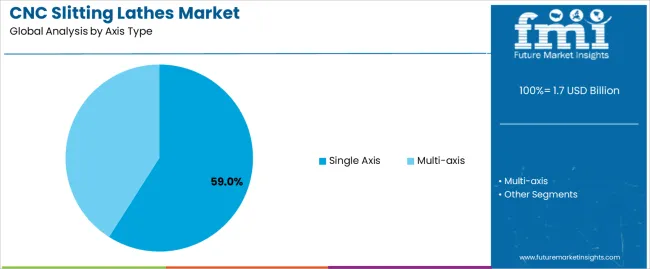
Market Position: Single Axis systems command the leading position in the CNC slitting lathes market with 59% market share through proven operational features, including superior cost efficiency, operational simplicity, and precision manufacturing capabilities that enable production facilities to achieve optimal turning performance across diverse medical device and component manufacturing environments.
Value Drivers: The segment benefits from manufacturing facility preference for reliable turning systems that provide consistent machining performance, lower maintenance requirements, and operational cost optimization without requiring extensive operator training programs. Advanced design features enable high-precision turning, rapid cycle times, and integration with existing production workflows, where operational reliability and total cost of ownership represent critical facility requirements.
Competitive Advantages: Single Axis systems differentiate through proven manufacturing reliability, consistent precision characteristics, and integration with automated material handling systems that enhance facility productivity while maintaining optimal quality standards suitable for diverse medical device and automotive applications.
Key market characteristics:
Multi-axis systems maintain a 41% market position in the CNC slitting lathes market due to their complex machining properties and productivity advantages. These systems appeal to facilities requiring simultaneous multi-surface machining with reduced setup times for aerospace and advanced manufacturing applications. Market growth is driven by component complexity increases, emphasizing complete machining solutions and operational efficiency through integrated system designs.
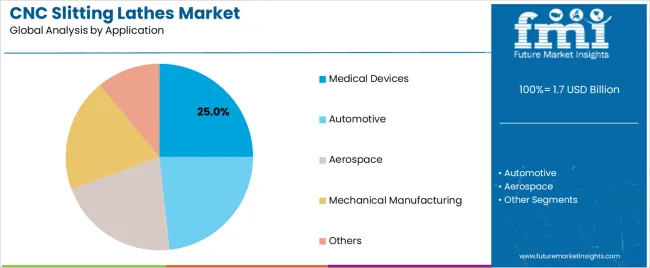
Market Context: Medical Devices applications accounts for 25% market share demonstrate the highest growth rate in the CNC slitting lathes market with 7.2% CAGR due to widespread adoption of precision machining systems and increasing focus on implant production optimization, biocompatible component manufacturing, and regulatory compliance applications that maximize quality consistency while maintaining stringent tolerance standards.
Appeal Factors: Medical device operators prioritize system precision, process validation capabilities, and integration with quality management infrastructure that enables coordinated manufacturing operations across multiple production batches. The segment benefits from substantial medical technology investment and production expansion programs that emphasize the acquisition of validated machining systems for implant production and surgical instrument manufacturing applications.
Growth Drivers: Orthopedic implant production programs incorporate CNC slitting lathes as essential equipment for bone screw manufacturing, dental implant fabrication, and spinal component production, while minimally invasive surgical device trends increase demand for micro-component machining capabilities that comply with FDA quality standards and minimize production variability.
Market Challenges: Varying material requirements and validation complexity may limit system standardization across different device types or regulatory scenarios.
Application dynamics include:
Automotive applications capture market share through high-volume production requirements in fuel system components, transmission parts, and precision fastener manufacturing. These facilities demand reliable machining systems capable of operating with consistent quality while providing effective cost-per-part optimization and production flexibility capabilities.
Aerospace applications account for market share, including turbine component production, landing gear manufacturing, and structural fastener fabrication requiring maximum precision capabilities for safety-critical component optimization and material traceability.
| Category | Factor | Impact | Why It Matters |
|---|---|---|---|
| Driver | Medical device manufacturing growth & aging population demographics (implant demand) | ★★★★★ | Orthopedic and dental implant production requires ultra-precision turning solutions with validated processes and consistent quality across production volumes. |
| Driver | Automotive lightweighting & electric vehicle components (precision shaft production) | ★★★★★ | Turns specialized machining from optional to mandatory; vendors offering multi-material capability and tight tolerance control gain competitive advantage. |
| Driver | Aerospace component complexity & material diversity (titanium, composites) | ★★★★☆ | Aircraft manufacturers need versatile machining systems; demand for difficult-material capability and process reliability expanding addressable market. |
| Restraint | High capital investment & skilled operator shortage (especially advanced systems) | ★★★★☆ | Small manufacturers face financial barriers; increases adoption hesitation and slows automated equipment penetration in emerging markets. |
| Restraint | Complex programming & setup requirements (multi-axis systems) | ★★★☆☆ | Specialized applications require extensive process development and validation procedures, limiting operational flexibility and increasing implementation complexity. |
| Trend | Industry 4.0 integration & predictive maintenance (IoT sensors, machine learning) | ★★★★★ | Real-time monitoring, tool life prediction, and automated quality control transform operations; connectivity and data analytics become core value propositions. |
| Trend | Additive-subtractive hybrid manufacturing (combined technologies) | ★★★★☆ | Integrated systems combining 3D printing and precision machining; hybrid platforms offering complete component production drive competition toward multi-process solutions. |
The CNC slitting lathes market demonstrates varied regional dynamics with Growth Leaders including China (7.2% growth rate) and India (6.6% growth rate) driving expansion through precision manufacturing initiatives and medical device production development. Steady Performers encompass Germany (6.1% growth rate), United States (5.0% growth rate), and developed regions, benefiting from established precision engineering industries and advanced manufacturing adoption. Emerging Markets feature Brazil (5.6% growth rate) and developing regions, where manufacturing modernization and precision component production support consistent growth patterns.
Regional synthesis reveals East Asian markets leading adoption through medical device manufacturing expansion and automotive component production development, while South Asian countries maintain strong growth supported by precision manufacturing infrastructure advancement and production capacity initiatives. North American markets show steady expansion driven by aerospace manufacturing requirements and medical device production standards, while European markets demonstrate moderate growth influenced by precision engineering applications and automotive component trends.
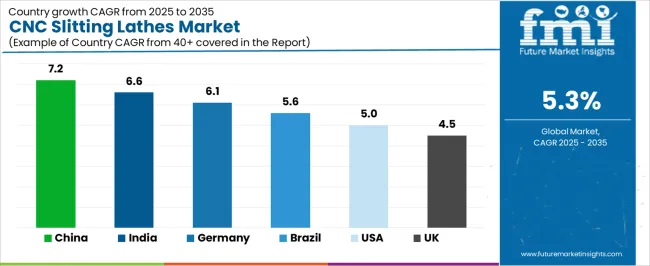
| Region/Country | 2025-2035 Growth | How to win | What to watch out |
|---|---|---|---|
| China | 7.2 | Lead with localized support | Price competition; IP protection challenges |
| India | 6.6 | Focus on medical device applications | Infrastructure gaps; skill availability |
| Germany | 6.1 | Offer premium precision systems | Over-engineering; lengthy decision cycles |
| Brazil | 5.6 | Provide financing solutions | Currency fluctuations; economic instability |
| United States | 5.0 | Push automation integration | Market maturity; skilled labor shortage |
| United Kingdom | 4.5 | Emphasize aerospace applications | Manufacturing decline; Brexit impacts |

China establishes fastest market growth through aggressive precision manufacturing programs and comprehensive medical device production development, integrating CNC slitting lathes as essential components in orthopedic implant production, automotive component manufacturing, and precision mechanical part installations. The country's 7.2% growth rate reflects government initiatives promoting medical device industry advancement and manufacturing capability enhancement that mandate the use of precision turning systems in medical and automotive facilities. Growth concentrates in major manufacturing hubs, including Guangdong, Jiangsu, and Zhejiang provinces, where medical device operations showcase integrated precision machining systems that appeal to manufacturers seeking advanced production capabilities and quality optimization applications.
Chinese manufacturers are developing cost-effective machining solutions that combine domestic production advantages with adequate precision features, including reliable spindle systems and basic automation compatibility. Distribution channels through industrial equipment distributors and manufacturer-direct sales expand market access, while government support for medical device manufacturing supports adoption across diverse medical implant and automotive component segments.
Strategic Market Indicators:
In Pune, Bangalore, and Chennai, medical device facilities and automotive component plants are implementing CNC slitting lathes as standard equipment for precision production and quality optimization applications, driven by increasing government manufacturing investment and Make in India programs that emphasize the importance of precision machining capabilities. The market holds a 6.6% growth rate, supported by government medical device production initiatives and manufacturing infrastructure development programs that promote advanced turning systems for medical and automotive facilities. Indian operators are adopting machining systems that provide reliable operational performance and cost-effective features, particularly appealing in urban regions where production quality and regulatory compliance represent critical operational requirements.
Market expansion benefits from growing medical device manufacturing capabilities and automotive component localization programs that enable domestic demand for precision turning systems for industrial applications. Technology adoption follows patterns established in precision manufacturing equipment, where reliability and value drive procurement decisions and operational deployment.
Market Intelligence Brief:
Germany establishes technology leadership through comprehensive precision engineering programs and advanced manufacturing infrastructure development, integrating CNC slitting lathes across medical device, automotive, and aerospace manufacturing applications. The country's 6.1% growth rate reflects established precision machining industry relationships and mature turning technology adoption that supports widespread use of advanced CNC systems in component manufacturing facilities. Growth concentrates in major industrial centers, including Baden-Württemberg, Bavaria, and North Rhine-Westphalia, where medical device operations showcase premium system deployment that appeals to manufacturers seeking proven ultra-precision capabilities and process validation applications.
German equipment providers leverage established distribution networks and comprehensive engineering capabilities, including application support programs and process optimization services that create customer relationships and operational advantages. The market benefits from mature quality standards and regulatory requirements that support precision machining use while encouraging technology advancement and process optimization.
Market Intelligence Brief:
United States demonstrates market leadership through comprehensive medical device programs and advanced aerospace manufacturing infrastructure development, integrating CNC slitting lathes across implant production, surgical instrument manufacturing, and aerospace component applications. The country's 5.0% growth rate reflects established medical device industry relationships and mature precision machining adoption that supports widespread use of validated turning systems in regulated manufacturing facilities. Growth concentrates in major medical device centers, including Minnesota, Massachusetts, and California, where orthopedic operations showcase mature system deployment that appeals to manufacturers seeking proven FDA-compliant capabilities and process validation applications.
American equipment providers prioritize system validation and process documentation in machining equipment development, creating demand for proven solutions with comprehensive support, including validation protocols and regulatory documentation services. The market benefits from established quality system infrastructure and willingness to invest in validated manufacturing technologies that provide regulatory compliance and quality assurance benefits.
Market Intelligence Brief:
Brazil's market expansion benefits from diverse manufacturing demand, including precision component modernization in São Paulo and automotive production development, manufacturing facility upgrades, and government industrial programs that increasingly incorporate precision machining solutions for quality optimization applications. The country maintains a 5.6% growth rate, driven by rising automotive manufacturing activity and increasing recognition of precision machining benefits, including improved component quality and enhanced production efficiency.
Market dynamics focus on cost-effective precision machining solutions that balance adequate operational performance with affordability considerations important to Brazilian manufacturing operators. Growing industrial development creates continued demand for modern turning systems in new facility infrastructure and manufacturing modernization projects.
Strategic Market Considerations:
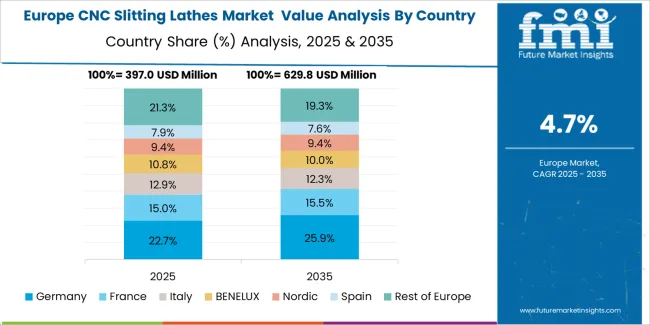
The European CNC slitting lathes market is projected to grow from USD 623.1 million in 2025 to USD 859.0 million by 2035, registering a CAGR of 3.3% over the forecast period. Germany is expected to maintain its leadership position with a 39.4% market share in 2025, supported by its advanced precision engineering infrastructure and major medical device production centers.
Switzerland follows with a 18.7% share in 2025, driven by comprehensive medical device manufacturing programs and watch component production traditions. Italy holds a 16.3% share through specialized mechanical manufacturing applications and automotive component requirements. France commands a 13.9% share, while United Kingdom accounts for 11.7% in 2025. The rest of Europe region is anticipated to gain momentum, expanding its collective share from 5.6% to 6.4% by 2035, attributed to increasing precision machining adoption in Nordic countries and emerging Central European manufacturing facilities implementing production modernization programs.
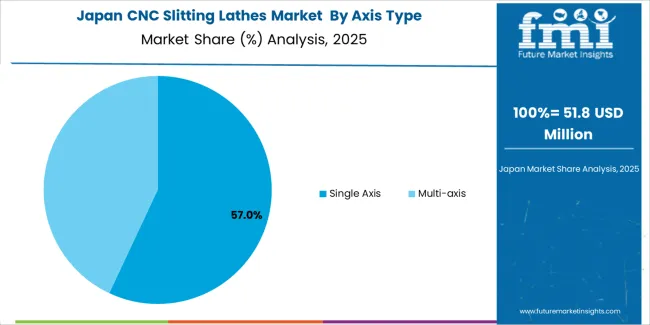
Japan maintains established market position with 4.0% growth rate through comprehensive precision manufacturing programs and advanced machining technology infrastructure, integrating CNC slitting lathes across medical device facilities in Tokyo, automotive component production in Nagoya, and precision manufacturing operations throughout industrial regions. The market demonstrates mature adoption patterns with 92% penetration rate in precision component manufacturing facilities, supported by established quality culture and continuous improvement methodologies. Japanese manufacturers emphasize system precision and reliability capabilities, creating demand for ultra-high-performance solutions with advanced features including thermal compensation systems and nanometer-level positioning accuracy. Manufacturing operators prioritize turning systems that provide exceptional consistency with existing quality infrastructure and maintain strict tolerance standards suitable for Japanese manufacturing requirements.

South Korea demonstrates advanced manufacturing innovation with 4.3% growth rate through comprehensive industrial automation and precision manufacturing technology development, particularly in automotive component operations and electronics manufacturing facilities where companies implement cutting-edge precision turning systems. The market benefits from high automation adoption rates and established precision engineering infrastructure, enabling rapid deployment of advanced machining solutions with 86% robotic integration prevalence in component production. Korean manufacturers integrate smart manufacturing capabilities and predictive maintenance features, creating distinctive machining systems that appeal to technology-forward manufacturing environments. Government support for smart factory initiatives and manufacturing competitiveness programs drives continued precision machining system adoption across diverse industrial sectors.
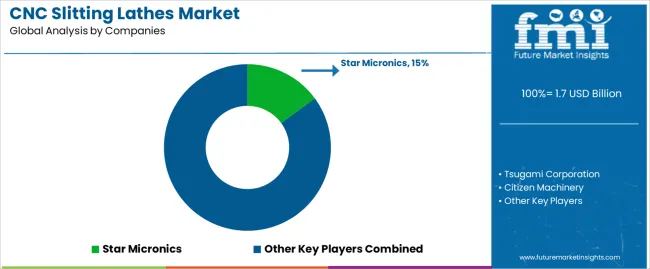
The CNC slitting lathes market structure consists of 18-24 credible manufacturers with the top 5-7 companies controlling approximately 62-67% of market revenue. Leadership positions are maintained through technological innovation excellence, comprehensive service networks, and continuous precision enhancement encompassing thermal stability improvement, automation advancement, and seamless integration with manufacturing execution systems. Standard single-axis configurations and basic CNC functionality are becoming commoditized offerings as market maturity increases and precision requirements escalate across applications.
Margin opportunities concentrate in advanced multi-axis systems, application-specific tooling packages, and integration into customer production ecosystems including quality management systems, predictive maintenance platforms, and digital manufacturing workflows. Long-term partnerships with medical device manufacturers, automotive tier suppliers, and aerospace component producers provide stable revenue streams, while value-added services including process validation support, operator training programs, and performance optimization consulting create differentiation opportunities beyond standard equipment sales.
Manufacturers pursuing growth strategies emphasize vertical specialization into high-growth application segments including medical implant production, electric vehicle component manufacturing, and aerospace precision parts fabrication. Strategic partnerships with tooling suppliers, automation integrators, and quality system providers enable comprehensive turnkey solutions addressing complete manufacturing requirements. Technology investments focus on artificial intelligence capabilities for process optimization, digital twin technologies for virtual commissioning, and advanced sensor systems for real-time quality monitoring and adaptive control scenarios.
| Stakeholder | What they actually control | Typical strengths | Typical blind spots |
|---|---|---|---|
| Global platforms | Distribution networks, service infrastructure, technology portfolios | Broad capabilities, proven reliability, comprehensive support | Innovation speed; niche application expertise |
| Technology innovators | Advanced control systems; multi-axis capabilities; precision engineering | Latest features first; performance leadership | Service density outside core markets; cost positioning |
| Regional specialists | Local support, rapid response, market knowledge | Customer proximity; responsive service; practical solutions | Technology advancement; global reach limitations |
| Application-focused providers | Industry expertise, validated processes, turnkey solutions | Lowest application risk; regulatory compliance | Flexibility limits; narrow market focus |
| Service-oriented ecosystems | Uptime programs, training networks, process support | Maximum productivity; comprehensive assistance | Service complexity; dependency creation |
| Item | Value |
|---|---|
| Quantitative Units | USD 1.7 million |
| Axis Type | Single Axis, Multi-axis |
| Application | Medical Devices, Automotive, Aerospace, Mechanical Manufacturing, Others |
| Regions Covered | North America, Latin America, Western Europe, Eastern Europe, East Asia, South Asia Pacific, Middle East & Africa |
| Countries Covered | United States, China, Germany, India, United Kingdom, Japan, Canada, Brazil, France, Australia, South Korea, Switzerland, and 24+ additional countries |
| Key Companies Profiled | Star Micronics, Tsugami Corporation, Citizen Machinery, Nexturn Bioscience, Tornos, TAJMAC Group, Hanwha Semitech, DMG MORI, DN Solutions, Nomura DS |
| Additional Attributes | Revenue analysis by axis type and application categories, regional adoption trends across East Asia, South Asia Pacific, and Western Europe, competitive landscape with precision machining manufacturers and CNC equipment suppliers, manufacturing operator preferences for precision control and system reliability, integration with automation platforms and quality management systems, innovations in turning technology and multi-axis capabilities, and development of intelligent machining solutions with predictive maintenance capabilities and manufacturing optimization features. |
The global cnc slitting lathes market is estimated to be valued at USD 1.7 billion in 2025.
The market size for the cnc slitting lathes market is projected to reach USD 2.8 billion by 2035.
The cnc slitting lathes market is expected to grow at a 5.3% CAGR between 2025 and 2035.
The key product types in cnc slitting lathes market are single axis and multi-axis.
In terms of application, medical devices segment to command 25.0% share in the cnc slitting lathes market in 2025.






Full Research Suite comprises of:
Market outlook & trends analysis
Interviews & case studies
Strategic recommendations
Vendor profiles & capabilities analysis
5-year forecasts
8 regions and 60+ country-level data splits
Market segment data splits
12 months of continuous data updates
DELIVERED AS:
PDF EXCEL ONLINE
CNC Abovefloor Wheel Lathe Market Size and Share Forecast Outlook 2025 to 2035
CNC Industrial Paper Cutter Market Size and Share Forecast Outlook 2025 to 2035
CNC Plasma Cutting Machines Market Size and Share Forecast Outlook 2025 to 2035
CNC Controller Market Size and Share Forecast Outlook 2025 to 2035
CNC Tool Storage System Market
Desktop CNC Milling Machines Market Size and Share Forecast Outlook 2025 to 2035
Railway CNC Wheel Lathe Market Size and Share Forecast Outlook 2025 to 2035
Tabletop CNC Milling Machines Market Analysis - Size, Share, and Forecast Outlook 2025 to 2035
Woodworking CNC Tools Market Size and Share Forecast Outlook 2025 to 2035
Examining Market Share Trends in Woodworking CNC Tools
Slitting Machine Market Growth – Trends & Forecast 2025-2035
Roll Slitting Machine Market
Laser-Assisted Smart Lathes Market Size and Share Forecast Outlook 2025 to 2035

Thank you!
You will receive an email from our Business Development Manager. Please be sure to check your SPAM/JUNK folder too.
Chat With
MaRIA